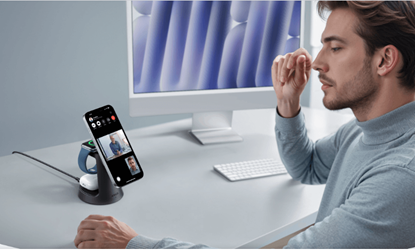Avegant Glyph
I first heard about the
Avegant Glyph
while browsing Reddit, where a
post
titled, "The Avegant Glyph projects images directly on to your retinas," caught my eye.
Click.
The post linked to a review of the futuristic headset (and a lengthy essay about the future) from
Dieter Bohn at The Verge
.
Advertisement
The Glyph doesn't have a screen; it sort of uses your eyes as the screen.
"Avegant's patented Retinal Imaging Technology uses advanced optics and an array of two million mirrors to project images directly to your eyes to recreate natural sight," the company says on its
website
. "It's more like seeing than watching - and far better than any other display technology."
Bohn agreed the experience was incredibly immersive, but he also acknowledged it could be tiring:
TOP VIDEOS FOR YOU
10:21
Meet the women keeping a 2,000-year-old Indigenous craft alive in Guatemala
Play icon
A circle surrounding a triangle pointing right. It indicates, "this type of media can be played."
06:10
A company in India has found a way to recycle cigarette butts into toys and mosquito repellant
Play icon
A circle surrounding a triangle pointing right. It indicates, "this type of media can be played."
12:59
US vs UK Jollibee | Food Wars
Play icon

A circle surrounding a triangle pointing right. It indicates, "this type of media can be played."
11:10
The rise and fall of Beanie Babies, which made Ty Warner a billionaire but now are nearly worthless
Play icon
A circle surrounding a triangle pointing right. It indicates, "this type of media can be played."
07:28
Vegetable tanned leather is an old tradition in Tuscany. Here's why it's so expensive.
Advertisement
"After just a couple hours, though, you'll probably find that your nose hurts and your eyes are a little tired. The screen on the Glyph has three brightness settings and all of them are searingly intense. When you take the Glyph off, you'll have a ghostly square hovering in your field of vision, like you were staring at a pixelated sun."
I thought, 'This has to be bad for your eyes, right?'
Advertisement
So I reached out to
Marty Banks
, a professor of optometry and vision science at the University of California, Berkeley. His lab studies the effects that emerging technology, screens, and virtual reality headsets have on our eyes.
"It all depends on the light levels, the light concentration. There's nothing inherently bad about projecting directly onto the retina," Banks told Tech Insider.
"If all the light was brought into one point on the retina, then you could worry about injuring the retina," he said. "But I'm sure that whoever is designing this thing - in fact I would hope - has thought that through at great length and knows what their light levels are like compared to safe levels."
Advertisement
Avegant Glyph
So you probably don't have to worry about the Avegant Glyph wrecking your eyes, though it's always important that scientists keep testing these things for safety, in case there are problems we haven't found yet.
The Glyph was born out of a
Kickstarter campaign
in 2014, for which over 3,300 people pledged $1.5 million to bring to life. The Founder's Edition costs
$699
.
Advertisement
NOW WATCH:
I just tried virtual reality for the first time, and it blew my mind
Please enable Javascript to watch this video









